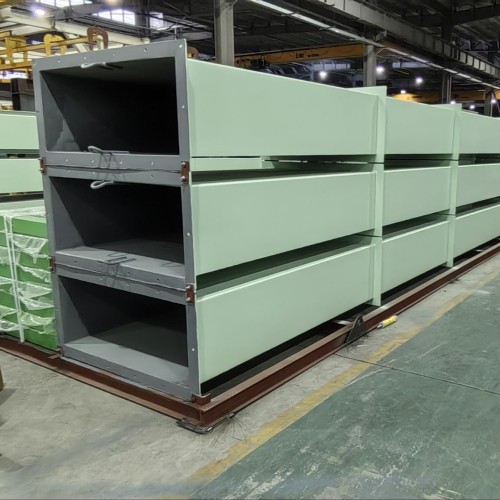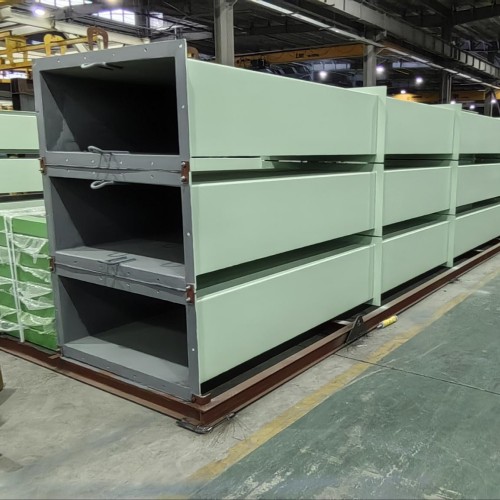
En-Masse Chain Conveyors
En-Masse Chain Conveyors
En-Masse Chain Conveyors are specialized bulk material handling systems designed to transport materials in a continuous “en-masse” flow. They rely on a chain and flight system within an enclosed trough, making them highly efficient, dust-free, and versatile for a wide range of industries such as power plants, waste-to-energy facilities, cement plants, and agriculture.
What Does “En-Masse” Mean?
The term “en-masse” refers to the movement of material as a single, uniform body, where particles are moved in unison without significant internal friction. The conveyor’s design ensures that the material fills the trough and is transported by the chain’s gentle push.
Key Features of En-Masse Chain Conveyors
- Compact Design:
- The enclosed system allows for horizontal, inclined, or vertical configurations, making it ideal for tight spaces.
- Gentle Material Handling:
- Low-speed operation minimizes material degradation, making it suitable for fragile, abrasive, or high-value materials.
- Dust-Free Operation:
- Fully enclosed design prevents spillage and protects materials from contamination.
- Versatile Material Handling:
- Suitable for a wide range of materials, from fine powders to coarse, abrasive solids.
- Energy Efficiency:
- The low-speed, friction-based transport system requires less energy than other conveyors.
- Customizable:
- Can be tailored to specific capacities, layouts, and material characteristics.
Applications of En-Masse Chain Conveyors
- Power Plants:
- Bottom ash, fly ash, and coal transport.
- Waste-to-Energy Plants:
- Handling ash, slag, and other combustion byproducts.
- Cement Plants:
- Transporting raw materials, clinker, and gypsum.
- Agriculture:
- Moving grains, seeds, and feed in silos and storage facilities.
- Mining:
- Handling ore, coal, and other bulk materials in harsh environments.
- Chemical and Fertilizer Plants:
- Transporting corrosive or fine granular materials.
Components of an En-Masse Chain Conveyor
- Chain and Flights:
- Heat-treated, wear-resistant chain with flights that push material in the trough.
- Enclosed Trough:
- Provides a dust-tight housing for the material, preventing contamination or spillage.
- Drive Unit:
- Powers the chain for consistent and controlled material movement.
- Head Section:
- Discharges the material at the end of the conveyor.
- Tail Section:
- Allows material to enter the conveyor while maintaining chain tension.
- Tensioning System:
- Keeps the chain taut to ensure smooth and efficient operation.
- Inspection Ports:
- For maintenance and monitoring of the conveyor system.
Working Principle of En-Masse Chain Conveyors
- Material Loading:
- Bulk material enters the conveyor trough at the inlet.
- Transport:
- The chain with attached flights moves through the trough, pushing the material forward in a uniform “en-masse” flow.
- Friction between the material particles and the flights ensures that material moves in unison.
- Discharge:
- Material is discharged through gravity or via a controlled outlet at the head section.
Advantages of En-Masse Chain Conveyors
- High Efficiency:
- Handles large volumes of material with minimal energy consumption.
- Space-Saving:
- Can be configured for horizontal, inclined, or vertical transport.
- Low Maintenance:
- Fewer moving parts and durable construction reduce wear and tear.
- Environmental Compliance:
- Enclosed design minimizes dust emissions and spillage.
- Durability:
- Constructed with wear-resistant materials for long service life in harsh environments.
- Flexibility:
- Can handle a wide variety of bulk materials, including hot, abrasive, or corrosive substances.
Comparison with Other Conveyors
| Feature | En-Masse Chain Conveyor | Belt Conveyor | Screw Conveyor |
|---|---|---|---|
| Material Types | Wide range (fine to coarse) | Limited (non-abrasive) | Limited (non-fragile) |
| Space Efficiency | High | Medium | Low |
| Dust Control | Excellent | Moderate | Moderate |
| Energy Efficiency | High | Medium | Low |
| Maintenance Needs | Low | Moderate | High |
Types of En-Masse Chain Conveyors
- Horizontal En-Masse Conveyors:
- Designed for long-distance transport on a horizontal plane.
- Inclined En-Masse Conveyors:
- Suitable for moving materials at an upward or downward angle.
- Vertical En-Masse Conveyors:
- Used for lifting materials vertically to silos or higher levels.
- Reversing En-Masse Conveyors:
- Capable of transporting materials in both directions, increasing operational flexibility.
Why Choose En-Masse Chain Conveyors?
- Efficiency:
- High throughput with minimal energy use.
- Versatility:
- Handles a wide range of materials in different configurations.
- Environmental Benefits:
- Fully enclosed system reduces dust, spillage, and contamination.
- Cost-Effectiveness:
- Durable construction and low maintenance reduce operational costs over time.
- Adaptability:
- Customizable to specific plant layouts and capacity requirements.
If you’re considering an En-Masse Chain Conveyor for your operations, I can help design a solution tailored to your material handling needs. Let me know your requirements, and we can explore the most efficient and cost-effective options!




